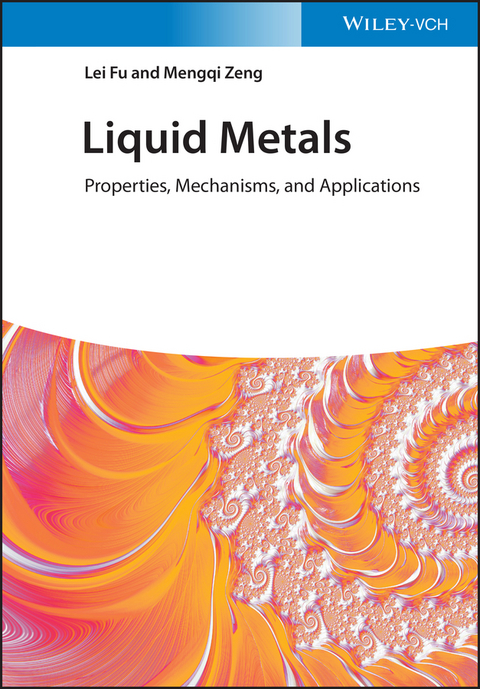Liquid Metals
Wiley-VCH (Verlag)
978-3-527-82818-0 (ISBN)
Lei Fu is a professor in College of Chemistry and Molecular Sciences, Wuhan University. Prof. Lei Fu has achieved a series of comprehensive and unique research works in the controlled growth of 2D materials and proposed the novel liquid-metal chemical vapor deposition strategy. Lei Fu has authored/co-authored more than 150 SCI papers in peer reviewed journals. He was honored with the Yangtze River Young Scholar and awarded the Outstanding Youth Science Foundation in China. Currently, he is a member of the Youth Committee of the Chinese Chemical Society and a member of the Nano Chemistry Professional Committee.Mengqi Zeng received her B.S. degree from Wuhan University in 2013. She then received her Ph.D. degree from the College of Chemistry and Molecular Sciences at Wuhan University. In 2018, she joined Wuhan University as an associate professor. Her current research is focused on the controllable synthesis and self-assembly of 2D materials on liquid metals.
PART I FUNDAMENTALS OF LIQUID METAL
1 INTRODUCTION
1.1 The discovery and development history of liquid metal
1.2 Liquid metal family
1.3 Overview of liquid metal
2 STRUCTURE AND PHYSICAL PROPERTIES OF LIQUID METAL
2.1 Structure of liquid metal
2.2 Low melting point of liquid metal
2.3 Rheological properties of liquid metal
2.4 Electrical conductivity of liquid metal
2.5 Thermal property of liquid metal
2.6 Surface properties of liquid metal
2.7 Liquid metal in other dimensions
2.8 Conclusion
3 PREPARATION OF LIQUID METAL
3.1 Introduction
3.2 Preparation of liquid metal droplets
3.3 Preparation of liquid metal nanowires
3.4 Preparation of liquid metal nanosheets
3.5 Conclusion and prospect
4 EXTERNAL FIELD TUNING OF LIQUID METAL
4.1 Introduction
4.2 Electrical field tuning
4.3 Magnetic field tuning
4.4 Chemical tuning
4.5 Force field tuning
4.6 Others
4.7 Conclusion and prospect
PART II EMERGENT APPLICATIONS OF LIQUID METAL
5 LIQUID METAL AS A NEW REACTION MEDIUM
5.1 Introduction
5.2 Nanomaterial synthesis
5.3 Alloy preparation
5.4 Conclusion and prospect
6 CONSTRUCTING TECHNIQUES OF LIQUID METAL-BASED ARCHITECTURES
6.1 Introduction
6.2 Injecting
6.3 Imprinting
6.4 Mask-assisted depositing
6.5 Direct writing
6.6 Laser ablating
6.7 External field guiding
6.8 Others
6.9 Conclusion and prospect
7 LIQUID METAL TOWARD FLEXIBLE ELECTRONICS
7.1 Introduction
7.2 Traditional materials for flexible electronics
7.3 Advantages of liquid metals
7.4 Construction strategies for liquid-metal-based flexible electronics
7.5 Typical flexible electronics based on liquid metals
7.6 Summary and outlook
8 LIQUID METAL FOR BIOMEDICINE
8.1 Introduction
8.2 Therapeutics
8.3 Biomedical imaging
8.4 Biomimetics
8.5 Biodevices
8.6 Conclusion and prospect
9 LIQUID METAL FOR ENERGY
9.1 Introduction
9.2 Liquid metal as electrodes
9.3 Liquid metal as coolants
9.4 Liquid metal as catalysis
9.5 Conclusion and prospect
| Erscheinungsdatum | 20.04.2022 |
|---|---|
| Verlagsort | Weinheim |
| Sprache | englisch |
| Maße | 170 x 244 mm |
| Gewicht | 968 g |
| Themenwelt | Naturwissenschaften ► Chemie |
| Technik ► Maschinenbau | |
| Schlagworte | Chemie • Chemistry • Electrochemistry • Elektrochemie • Energie • Energiespeicherung • Energy • Energy Storage • Industrial Chemistry • Materials Science • Materialwissenschaften • Metalle • Metalle u. Legierungen • Metals & Alloys • Technische u. Industrielle Chemie |
| ISBN-10 | 3-527-82818-4 / 3527828184 |
| ISBN-13 | 978-3-527-82818-0 / 9783527828180 |
| Zustand | Neuware |
| Informationen gemäß Produktsicherheitsverordnung (GPSR) | |
| Haben Sie eine Frage zum Produkt? |
aus dem Bereich




